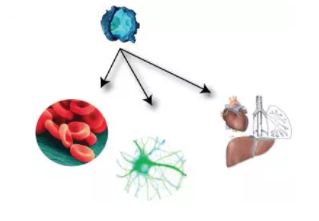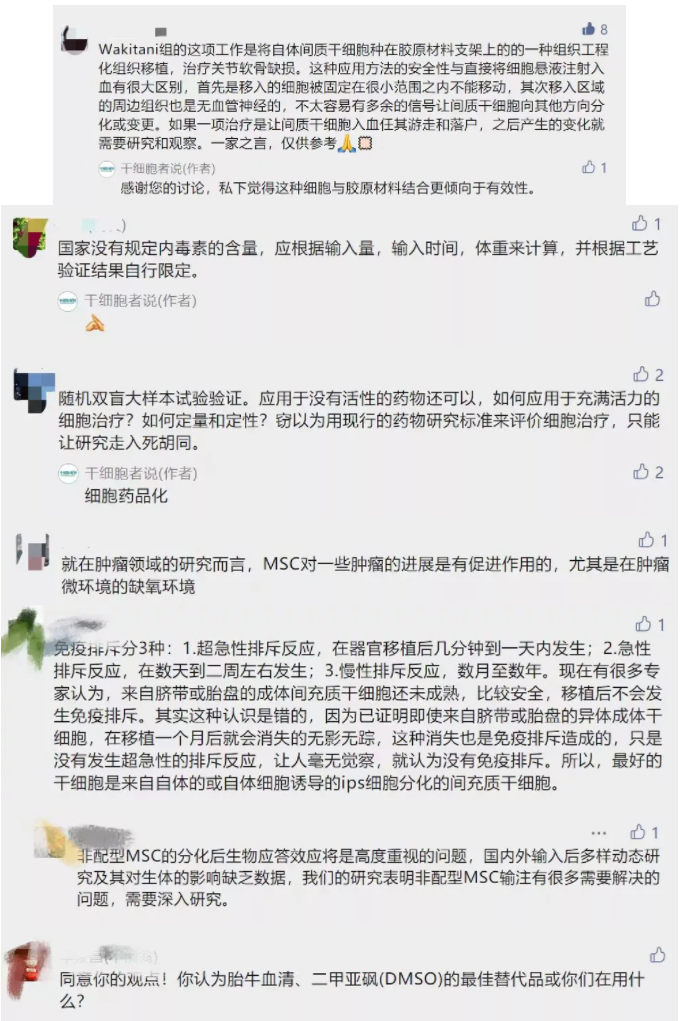虽然间充质干细胞(MSC)药物已经被一些国家批准上市,但是依然不少人对间充质干细胞的安全性充满疑虑。当然,这里指的是质量合格有保障的干细胞。虽然不少动物实验证明了输入间充质干细胞的安全性,但临床研究观察和评价更具有意义。
1
MSCs输入治疗后,发热是最常见的不良反应,文献中的最高发生率大概为39%[1-4]。一般无需特别处理,病人会自然恢复。有研究推测发烧的原因可能与输入异体MSCs引起的急性炎症反应有关[5]。但是,MSCs具有低免疫原性,而且有“免疫豁免”的特性,因此难于引起免疫排斥反应[6]。更直接的证据就是MSCs能有效地治疗各种免疫性疾病,尤其是治疗GVHD[7]。
动物实验证明MSCs能有效地治疗消除炎症[8]。有研究评价了137例类风湿性关节炎患者,患者在MSCs治疗后并不出现免疫毒性[9]。因此,MSCs治疗引起的发烧与免疫反应、炎症反应无关。
有研究发现利用胎牛血清(FBS)培养MSCs,可能会增加MSCs的免疫原性[10, 11]。但是大量的临床数据发现MSCs细胞悬液中的胎牛血清残留和不良反应没有关联性。即使如此,考虑到胎牛血清中存在大量的异种蛋白,我们也应该尽可能地降低MSCs细胞悬液中的胎牛血清残留量(国家规定不能超过50ng/ml)。
更值得注意的是,MSCs细胞悬液中含有二甲基亚砜(DMSO,细胞冻存必须要用的试剂)能明显增加毒副作用,引起超敏反应[1, 12,13]。因此,降低MSCs细胞悬液中含有二甲基亚砜的量能减少MSCs治疗引起的不良反应。
我们在临床应用中发现,如果MSCs悬液中的内毒素含量超标,则很容易引起发热,而与是否异体无关。胎牛血清残留量、二甲基亚砜和内毒素均与生产工艺密切相关,与间充质干细胞的细胞本身没有关系。
健康志愿者输入MSCs后,不出现输入性毒性反应(心率、呼吸、血氧饱和度、血压),各器官功能未见异常[14]。大部分研究发现患者输入MSCs后,没出现或者轻微的输入性毒性反应[2, 4, 7, 9,15-30]。仅有三个临床试验报道MSCs引起心脏毒性,表现为一过性心律不齐,发生率为7%(30例患者中有2例出现)[23, 31, 32]。只有一个随机对照试验发现MSCs治疗16名患者,有3名患者神经系统症状;而对照组36名患者中,有5名患者出现相同症状[16]。
虽然有一个非随机对照试验中,MSCs治疗组100名患者中的3名患者,及对照组100名患者中的3名患者,由于治疗后出现感染而导致死亡[33]。但是,更多的随机对照临床试验,通过统计学分析,发现MSCs治疗组和对照组的感染率没有差异,明确提出MSCs治疗不会增加感染的风险[15, 16, 18],而且MSCs治疗组和对照组在恶液质和成瘤方面没有差异[15-18]。长期观察也没有发现病人增加微生物感染和间充质干细胞致瘤的现象[7, 34]。更有学者给41例软骨损伤的病人输入MSCs治疗,观察了11年,均未发现肿瘤的发生[35]。
大样本临床研究证明MSCs治疗的安全性[7, 9, 36-38]。亦有学者对目前大量的临床试验的文献进行分析(Meta-Analysis),发现MSCs输入治疗仅仅与发热存在一定的关联性,而与其他文献所报道的不良反应没有必要的联系,认为MSC治疗是安全的[39]。
2
小结与问题
总体来看,间充质干细胞治疗具有良好的安全性记录,对病人无明显毒副作用,少数病人出现注射局部不适、短暂低热等,对症处理即可。
原文最早发表于间充质干细胞,“干细胞者说”科普平台授权转载,引起业内广泛讨论,那时候国内尚未有一项细胞药物申报。数年过去了,干细胞药物申请申请已经达到30个,其中获得默示许可的临床试验也已经22项,感慨万千,见证了中国干细胞行业从无序到有序。干细胞制剂安全性依然还是首要问题,但只要工艺靠谱,已不是大问题。
下面是当时评论留言(为保护隐私,码去昵称和头像),只留下精彩评论
2020年,《人源性干细胞及其衍生细胞治疗产品临床试验技术指导原则(征求意见稿)》
2019年,《GMP附录-细胞治疗产品》(征求意见稿)
2018年,《细胞治疗产品申请临床试验药学研究和申报资料的考虑要点》
2017年,《细胞治疗产品研究与评价技术指导原则(试行)》
2015年,《干细胞制剂质量控制及临床前研究指导原则(试行)》
2003年,《人体细胞治疗研究和制剂质量控制技术指导原则》
当然,还有 中国医药生物技术协会组织编写的《干细胞制剂制备质量管理自律规范》、深圳市细胞治疗协会组织编写的《临床研究用人脐带来源间充质干细胞制剂规范》、中国整形美容协会组织编写的《干细胞制剂制备与质检行业标准(试行)》等一些约束各自会员的标准。
[1]DuijvesteinM., Vos A. C., Roelofs H., et al. Autologous bone marrow-derived mesenchymalstromal cell treatment for refractory luminal Crohn's disease: results of aphase I study. Gut 2010;59(12):1662-1669.[2]Honmou O., Houkin K., MatsunagaT., et al. Intravenous administration of auto serum-expanded autologousmesenchymal stem cells in stroke. Brain 2011;134(Pt 6):1790-1807.[3]Karussis D., Karageorgiou C.,Vaknin-Dembinsky A., et al. Safety and immunological effects of mesenchymalstem cell transplantation in patients with multiple sclerosis and amyotrophiclateral sclerosis. Arch Neurol 2010;67(10):1187-1194.[4]Liang J., Zhang H., Wang D., etal. Allogeneic mesenchymal stem cell transplantation in seven patients withrefractory inflammatory bowel disease. Gut 2012;61(3):468-469.[5]Hendrickson J. E., Hillyer C. D.Noninfectious serious hazards of transfusion. Anesth Analg 2009;108(3):759-769.[6]Le Blanc K., Tammik C.,Rosendahl K., et al. HLA expression and immunologic properties ofdifferentiated and undifferentiated mesenchymal stem cells. Exp Hematol2003;31(10):890-896.[7]Le Blanc K., Frassoni F., BallL., et al. Mesenchymal stem cells for treatment of steroid-resistant, severe,acute graft-versus-host disease: a phase II study. Lancet 2008;371(9624):1579-1586.[8]Chang P., Qu Y., Liu Y., et al.Multi-therapeutic effects of human adipose-derived mesenchymal stem cells onradiation-induced intestinal injury. Cell Death Dis 2013;4e685.[9]Wang L., Cong X., Liu G., et al.Human umbilical cord mesenchymal stem cell therapy for patients with activerheumatoid arthritis: safety and efficacy. Stem Cells Dev2013;22(24):3192-3202.[10]Shahdadfar A., Fronsdal K.,Haug T., et al. In vitro expansion of human mesenchymal stem cells: choice ofserum is a determinant of cell proliferation, differentiation, gene expression,and transcriptome stability. Stem Cells 2005;23(9):1357-1366.[11]Spees J. L., Gregory C. A.,Singh H., et al. Internalized antigens must be removed to preparehypoimmunogenic mesenchymal stem cells for cell and gene therapy. Mol Ther2004;9(5):747-756.[12]Windrum P., Morris T. C., DrakeM. B., et al. Variation in dimethyl sulfoxide use in stem cell transplantation:a survey of EBMT centres. Bone Marrow Transplant 2005;36(7):601-603.[13]Syme R., Bewick M., Stewart D.,et al. The role of depletion of dimethyl sulfoxide before autografting: onhematologic recovery, side effects, and toxicity. Biol Blood Marrow Transplant2004;10(2):135-141.[14]Liu L., Sun Z., Chen B., et al.Ex vivo expansion and in vivo infusion of bone marrow-derived Flk-1+CD31-CD34-mesenchymal stem cells: feasibility and safety from monkey to human. Stem CellsDev 2006;15(3):349-357.[15]Hare J. M., Traverse J. H.,Henry T. D., et al. A randomized, double-blind, placebo-controlled,dose-escalation study of intravenous adult human mesenchymal stem cells(prochymal) after acute myocardial infarction. J Am Coll Cardiol2009;54(24):2277-2286.[16]Lee J. S., Hong J. M., Moon G.J., et al. A long-term follow-up study of intravenous autologous mesenchymalstem cell transplantation in patients with ischemic stroke. Stem Cells2010;28(6):1099-1106.[17]Lee P. H., Kim J. W., Bang O.Y., et al. Autologous mesenchymal stem cell therapy delays the progression ofneurological deficits in patients with multiple system atrophy. Clin PharmacolTher 2008;83(5):723-730.[18]Ning H., Yang F., Jiang M., etal. The correlation between cotransplantation of mesenchymal stem cells andhigher recurrence rate in hematologic malignancy patients: outcome of a pilotclinical study. Leukemia 2008;22(3):593-599.[19]Gonzalo-Daganzo R., Regidor C.,Martin-Donaire T., et al. Results of a pilot study on the use of third-partydonor mesenchymal stromal cells in cord blood transplantation in adults.Cytotherapy 2009;11(3):278-288.[20]Koc O. N., Day J., Nieder M.,et al. Allogeneic mesenchymal stem cell infusion for treatment of metachromaticleukodystrophy (MLD) and Hurler syndrome (MPS-IH). Bone Marrow Transplant2002;30(4):215-222.[21]Lazarus H. M., Koc O. N., DevineS. M., et al. Cotransplantation of HLA-identical sibling culture-expandedmesenchymal stem cells and hematopoietic stem cells in hematologic malignancypatients. Biol Blood Marrow Transplant 2005;11(5):389-398.[22]Lazarus H. M., Haynesworth S.E., Gerson S. L., et al. Ex vivo expansion and subsequent infusion of humanbone marrow-derived stromal progenitor cells (mesenchymal progenitor cells):implications for therapeutic use. Bone Marrow Transplant 1995;16(4):557-564.[23]Yang Z., Zhang F., Ma W., etal. A novel approach to transplanting bone marrow stem cells to repair humanmyocardial infarction: delivery via a noninfarct-relative artery. CardiovascTher 2010;28(6):380-385.[24]Zhang Z. X., Guan L. X., ZhangK., et al. A combined procedure to deliver autologous mesenchymal stromal cellsto patients with traumatic brain injury. Cytotherapy 2008;10(2):134-139.[25]Arima N., Nakamura F., FukunagaA., et al. Single intra-arterial injection of mesenchymal stromal cells fortreatment of steroid-refractory acute graft-versus-host disease: a pilot study.Cytotherapy 2010;12(2):265-268.[26]Liang J., Zhang H., Hua B., etal. Allogenic mesenchymal stem cells transplantation in refractory systemiclupus erythematosus: a pilot clinical study. Ann Rheum Dis 2010;69(8):1423-1429.[27]Weng J. Y., Du X., Geng S. X.,et al. Mesenchymal stem cell as salvage treatment for refractory chronic GVHD.Bone Marrow Transplant 2010;45(12):1732-1740.[28]Zhang X., Li J. Y., Cao K., etal. Cotransplantation of HLA-identical mesenchymal stem cells and hematopoieticstem cells in Chinese patients with hematologic diseases. Int J Lab Hematol2010;32(2):256-264.[29]Meuleman N., Tondreau T., AhmadI., et al. Infusion of mesenchymal stromal cells can aid hematopoietic recoveryfollowing allogeneic hematopoietic stem cell myeloablative transplant: a pilotstudy. Stem Cells Dev 2009;18(9):1247-1252.[30]Mohamadnejad M., AlimoghaddamK., Mohyeddin-Bonab M., et al. Phase 1 trial of autologous bone marrowmesenchymal stem cell transplantation in patients with decompensated livercirrhosis. Arch Iran Med 2007;10(4):459-466.[31]Sun L., Akiyama K., Zhang H.,et al. Mesenchymal stem cell transplantation reverses multiorgan dysfunction insystemic lupus erythematosus mice and humans. Stem Cells 2009;27(6):1421-1432.[32]Wang D., Zhang H., Cao M., etal. Efficacy of allogeneic mesenchymal stem cell transplantation in patientswith drug-resistant polymyositis and dermatomyositis. Ann Rheum Dis2011;70(7):1285-1288.[33]Vanikar A. V., Trivedi H. L.,Feroze A., et al. Effect of co-transplantation of mesenchymal stem cells andhematopoietic stem cells as compared to hematopoietic stem cell transplantationalone in renal transplantation to achieve donor hypo-responsiveness. Int UrolNephrol 2011;43(1):225-232.[34]Ball L. M., Bernardo M. E.,Roelofs H., et al. Cotransplantation of ex vivo expanded mesenchymal stem cellsaccelerates lymphocyte recovery and may reduce the risk of graft failure inhaploidentical hematopoietic stem-cell transplantation. Blood2007;110(7):2764-2767.[35]Wakitani S., Okabe T., HoribeS., et al. Safety of autologous bone marrow-derived mesenchymal stem celltransplantation for cartilage repair in 41 patients with 45 joints followed forup to 11 years and 5 months. J Tissue Eng Regen Med 2011;5(2):146-150.[36]Zhang Z., Fu J., Xu X., et al.Safety and immunological responses to human mesenchymal stem cell therapy indifficult-to-treat HIV-1-infected patients. AIDS 2013;27(8):1283-1293.[37]Zhang Z., Lin H., Shi M., etal. Human umbilical cord mesenchymal stem cells improve liver function andascites in decompensated liver cirrhosis patients. J Gastroenterol Hepatol2012;27 Suppl 2112-120.[38]Peng L., Xie D. Y., Lin B. L.,et al. Autologous bone marrow mesenchymal stem cell transplantation in liverfailure patients caused by hepatitis B: short-term and long-term outcomes.Hepatology 2011;54(3):820-828.[39]Lalu M. M., Mcintyre L.,Pugliese C., et al. Safety of cell therapy with mesenchymal stromal cells(SafeCell): a systematic review and meta-analysis of clinical trials. PLoS One2012;7(10):e47559.

